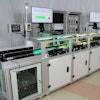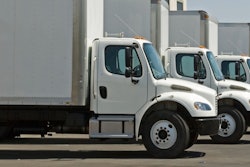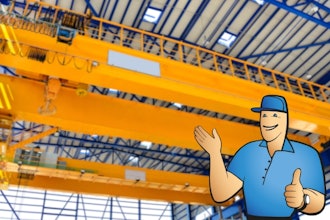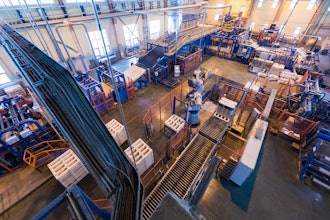Today's manufacturers are more productive than ever. Our clients are demanding higher quality products at tighter production times, and to meet those demands, the modern plant floor is filled with advanced machinery. Thanks to our high-tech assets, we have fewer inaccuracies, safer plant floors and less manual labor. But, when you combine complex machinery with big production demands, you can create premature wear and tear. This means that machine upkeep is of the utmost importance for your organization – so why are so many of us still relying on outdated maintenance routines?
From automated sensors performing condition monitoring after hours to automated processes, advanced maintenance is more important than ever in keeping our high-tech machines at high-productivity. But if you’re still relying on outdated data collection methods, or find yourselves scrambling to tackle last minute tasks, you can’t even begin to create an advanced maintenance routine, let alone get ahead on your backlog.
If you have complex machinery, you need a maintenance management solution that can keep up, which is why many organizations are now turning towards computerized maintenance management systems (CMMS). And, while many manufacturers already have a CMMS, not all software is created the same, and some may not be able to incorporate the advanced workflows needed to support modern plant floors. Whether you're just getting started with a CMMS or looking to switch to another solution, make sure it can help you maximize OEE with proactive work, analyze data for deeper insights and create a plan for long-term success.
Data On The Plant Floor
The value of proactive work can’t be understated. Proactive, or preventive, maintenance (PM) is absolutely essential; without it, you’re essentially running your machines to failure. A good place to start is to take a look at the “80/20 Rule.” Ideally, what you want to have is 80 percent proactive (or PM) work and just 20 percent reactive. Note that this is the ideal ratio; many maintenance teams fall short. The goal is to get as close to the 80/20 ratio as possible and use it as a benchmark.
With a CMMS, you can automatically schedule PM in the future at a pace of your choosing. When a PM task is created, you can also automate the assignment to your technicians based on location, asset work history and more. But, in order to really be proactive, you need to be able to pair PM with data.
One of the biggest benefits of a high-tech plant floor is that machines automatically provide data with minimal manual input. With everything going on in the day, crunching data on work orders or manually entering data can feel like an extra task that detracts from working on your assets. That’s why it’s important to have a tool that not only organizes work orders but provides you with valuable insights to help your team continuously improve.
How Software Impacts Maintenance
A CMMS stores all of your assets’ data in a central location, creating deeper understanding into your operations and enhancing visibility. This enhanced visibility can also help you make repair versus replace decisions. If, for example, a machine keeps failing, you can look into its historical work orders and estimate how much it will cost to repair it again. With that analysis, you may discover that it’s less expensive to fully replace it, and you can justify it in a budget request based on your CMMS’ data. With everything in one central dashboard, you can create a full picture of your asset ownership.
Best of all, you don’t need to invest in expensive new assets in order to take advantage of the benefits of data. For condition monitoring, for example, you can purchase aftermarket sensors for your existing machines. With these sensors, you can detect temperature fluctuations, analyze vibrations and more. And, these sensors can come in handy when you’re ready to take the next step from proactive to predictive maintenance.
Modern Maintenance: Beyond Proactive
With predictive maintenance (PdM), you can automate condition monitoring processes with the use of sensors. PdM analyzes historical data and real-time information so you capture a more detailed picture of your assets’ working lives, predicting a problem before it occurs. This means that you have a safeguard to prevent a disruption to your production schedule in between your scheduled PM. And, PdM minimizes downtime as you can capture information while equipment is running.
Some common types of condition monitoring include vibration analysis and acoustic analysis, and many CMMS is able to also track asset runtimes, cycle counts, widgets product and more. Whatever you choose to track, these sensors enable you to automate these monitoring processes and integrate them with your work. If, say, there’s a spike in an assets’ temperature, a sensor will detect it, create a work order in your CMMS and automatically route it to your technician – even if it’s after hours.
A well-designed PdM program analyzes historical data and real-time information so you capture a more detailed picture of your assets’ working lives without technician interference. This allows you to have peace of mind for your production schedule, save money on unforeseen repairs and extend the life of your assets.
Key Components In A CMMS
Both PM and PdM are effective at maximizing OEE, but they won’t make a big difference without a maintenance management system to tie it all together. In addition to these advanced maintenance capabilities, if you’re thinking about a CMMS, be sure to look for:
- Automated workflows — When a PM or PdM work order is created, you can create settings in your CMMS to automatically route these new tasks to the appropriate technician based on location, length of time, asset and more. You can also create email notifications so nothing is lost in the cracks, even if it’s after hours.
- Easy, detailed reporting — With all of the data in your machines, you want to make sure that your solution can take that information to give you insights. Your maintenance management system should be able to develop insights into all your data and help you translate this information into detailed reports for key stakeholders.
- Accurate budget forecasting — By predicting when a piece of equipment will fail or reach the end of its useful life, you can then accurately project those expenses into your budget. You’ll also be able to discover cost savings opportunities.
- Information on the go — A mobile-friendly CMMS will keep your technician on the plant floor without disruption. And, many vendors have apps that incorporate mobile functionality, such as photo attachments, QR codes and more.
Each manufacturer’s needs are different. With that in mind, there are key components that are absolutely (and universally) necessary in a CMMS in order to support both PM and PdM. In the end, however, choosing a solution that fits your long-term and short-term needs will yield the best outcome for your team, your machines and your clients.
Paul Lachance serves as the Senior Manufacturing Advisor for Dude Solutions.























